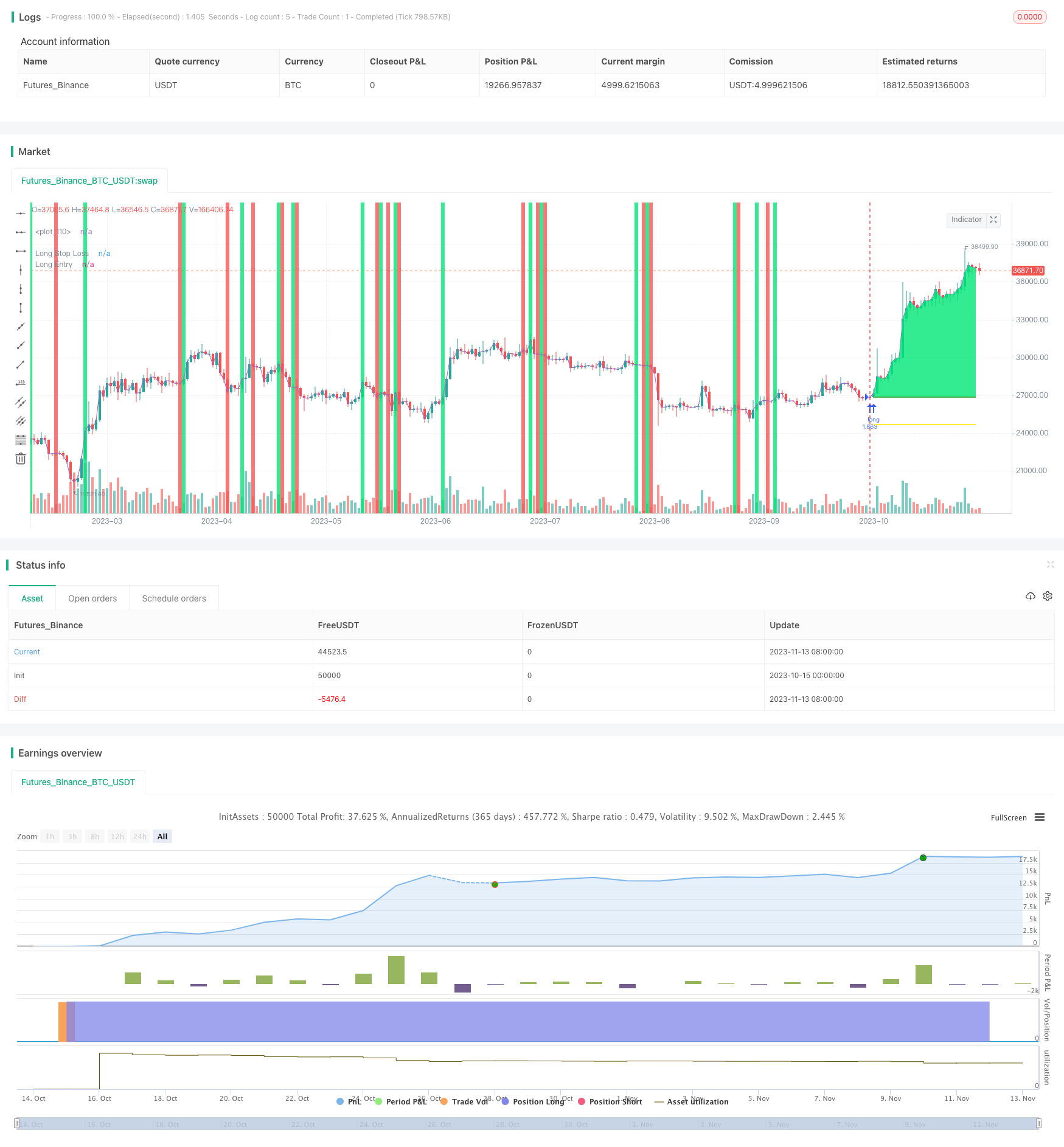
概述
动量突破策略是一种追随市场趋势的量化交易策略。它通过计算历史价格的动量指标,判断市场价格运动的趋势和力度,以捕捉市场的中长线趋势。当动量从负转正时做多,从正转负时做空,属于趋势跟踪策略。该策略适用于具有明显趋势的市场,可以获得超额收益。
策略原理
该策略主要基于动量指标。动量指标是当前周期收盘价减去N周期前的收盘价。当最新一根K线的收盘价高于N周期前时,动量为正,表示上涨势头;当最新一根K线的收盘价低于N周期前时,动量为负,表示下跌势头。
策略首先计算长度为18周期的动量,即当前收盘价减去18周期前的收盘价,得到mom0。然后再计算mom0的一周期动量,得到mom1。
当mom0>0且mom1>0时产生做多信号,此时表示价格上涨势头强劲;当mom0且mom1时产生做空信号,此时表示价格下跌势头强劲。
策略会记录最新一次做多和做空信号时间,当做多信号时间大于做空信号时间则持有做多仓位,当做空信号时间大于做多信号时间则持有做空仓位。
优势分析
该策略具有以下优势:
策略思路清晰简单,容易理解实现,适合量化交易初学者。
动量指标能够捕捉市场趋势和力度,追踪中长线趋势具有较高胜率。
采用双重动量过滤,可以过滤掉部分假突破造成的损失。
交易信号产生后会加仓建立趋势仓位,可以获得趋势行情的超额收益。
及时止损退出可以控制单笔损失,避免因反转造成过大损失。
风险分析
该策略也存在一些风险需要注意:
多头行情中短期调整造成止损退出,无法捕捉全周期行情。可以适当放宽止损范围。
震荡行情中存在频繁开仓平仓,容易增加交易费用和滑点损失。可以适当放宽过滤条件,减少交易频率。
趋势反转后仍持有原方向仓位造成损失扩大。可以结合趋势指标判断趋势逆转。
参数设置不当可能导致交易信号错失或产生错误信号。需要针对不同市场调整参数。
优化方向
该策略可以从以下几个方面进行优化:
优化动量参数,针对不同周期和市场调整计算动量的长度,改进信号质量。
增加其他指标过滤,如MACD,KD等,避免趋势反转造成损失。
优化止损策略,交易趋势中适当放宽止损;非趋势市场适当收紧止损。
增加仓位管理策略,非趋势行情减少仓位;趋势行情加大仓位以获取更多收益。
针对不同品种分别优化参数,提高参数适应性。
增加机器学习算法,让策略动态优化参数。
总结
动量突破策略overall是一个简单直观的趋势跟踪策略。它能够有效捕捉市场中长线趋势,在趋势行情中获得较好收益。同时也需要注意风险控制,优化止损策略,并辅助以其他指标判断趋势。通过不断优化,可以将该策略打造成一个稳定获利的量化交易系统。
/*backtest
start: 2023-10-15 00:00:00
end: 2023-11-14 00:00:00
period: 1d
basePeriod: 1h
exchanges: [{"eid":"Futures_Binance","currency":"BTC_USDT"}]
*/
//@version=4
strategy("Momentum BF 🚀", overlay=true, precision=2, initial_capital=10000, default_qty_type=strategy.percent_of_equity, default_qty_value=100, commission_type=strategy.commission.percent, commission_value=0.075)
/////////////// Time Frame ///////////////
_0 = input(false, "════════ Test Period ═══════")
testStartYear = input(2017, "Backtest Start Year")
testStartMonth = input(1, "Backtest Start Month")
testStartDay = input(1, "Backtest Start Day")
testPeriodStart = timestamp(testStartYear,testStartMonth,testStartDay, 0, 0)
testStopYear = input(2019, "Backtest Stop Year")
testStopMonth = input(12, "Backtest Stop Month")
testStopDay = input(31, "Backtest Stop Day")
testPeriodStop = timestamp(testStopYear,testStopMonth,testStopDay, 0, 0)
testPeriod() => true
///////////// Momentum /////////////
_1 = input(false, "═══════ Momentum ══════")
length = input(18)
price = close
momentum(seria, length) =>
mom = seria - seria[length]
mom
mom0 = momentum(price, length)
mom1 = momentum(mom0, 1)
/////////////// Strategy ///////////////
long = mom0 > 0 and mom1 > 0
short = mom0 < 0 and mom1 < 0
last_long = 0.0
last_short = 0.0
last_long := long ? time : nz(last_long[1])
last_short := short ? time : nz(last_short[1])
long_signal = crossover(last_long, last_short)
short_signal = crossover(last_short, last_long)
last_open_long_signal = 0.0
last_open_short_signal = 0.0
last_open_long_signal := long_signal ? open : nz(last_open_long_signal[1])
last_open_short_signal := short_signal ? open : nz(last_open_short_signal[1])
last_long_signal = 0.0
last_short_signal = 0.0
last_long_signal := long_signal ? time : nz(last_long_signal[1])
last_short_signal := short_signal ? time : nz(last_short_signal[1])
in_long_signal = last_long_signal > last_short_signal
in_short_signal = last_short_signal > last_long_signal
last_high = 0.0
last_low = 0.0
last_high := not in_long_signal ? na : in_long_signal and (na(last_high[1]) or high > nz(last_high[1])) ? high : nz(last_high[1])
last_low := not in_short_signal ? na : in_short_signal and (na(last_low[1]) or low < nz(last_low[1])) ? low : nz(last_low[1])
since_longEntry = barssince(last_open_long_signal != last_open_long_signal[1])
since_shortEntry = barssince(last_open_short_signal != last_open_short_signal[1])
/////////////// Stop Losses Long ///////////////
_5 = input(false, "═══════ Stop Loss L ══════")
SL_typel = input("Fixed", options=["Fixed", "ATR Derived"], title="Stop Loss Type")
sl_inpl = input(8.0, title='Fixed Stop Loss %') / 100
atrLkbl = input(20, minval=1, title='ATR Stop Period')
atrMultl = input(1.5, step=0.25, title='ATR Stop Multiplier')
atr1l = atr(atrLkbl)
longStop1l = 0.0
longStop1l := short_signal ? na : long_signal ? close - (atr1l * atrMultl) : longStop1l[1]
slLongl = in_long_signal ? strategy.position_avg_price * (1 - sl_inpl) : na
long_sll = in_long_signal ? slLongl : na
/////////////// Stop Losses Short ///////////////
_6 = input(false, "═══════ Stop Loss S ══════")
SL_types = input("Fixed", options=["Fixed", "ATR Derived"], title="Stop Loss Type")
sl_inps = input(7.0, title='Fixed Stop Loss %') / 100
atrLkbs = input(20, minval=1, title='ATR Stop Period')
atrMults = input(1.5, step=0.25, title='ATR Stop Multiplier')
atr1s = atr(atrLkbs)
shortStop1s = 0.0
shortStop1s := long_signal ? na : short_signal ? close + (atr1s * atrMults) : shortStop1s[1]
slShorts = strategy.position_avg_price * (1 + sl_inps)
short_sls = in_short_signal ? slShorts : na
_7 = input(false, "══════ Longs or Shorts ═════")
useLongs = input(true, title="Use Longs")
useShorts = input(true, title="Use Shorts")
/////////////// Execution ///////////////
if testPeriod()
if useLongs
strategy.entry("L", strategy.long, when=long)
strategy.exit("L SL", "L", stop = SL_typel == "Fixed" ? long_sll : longStop1l, when=since_longEntry > 0)
if useShorts
strategy.exit("S SL", "S", stop = SL_types == "Fixed" ? short_sls : shortStop1s, when=since_shortEntry > 0)
strategy.entry("S", strategy.short, when=short)
if not useShorts
strategy.close("L", when=short)
if not useLongs
strategy.close("S", when=long)
/////////////// Plotting ///////////////
bgcolor(long_signal ? color.lime : short_signal ? color.red : na, transp=40)
p0 = plot(close)
p1 = plot(strategy.position_size <= 0 ? na : SL_typel == "Fixed" ? long_sll : longStop1l, title="Long Stop Loss", color=color.yellow, style=plot.style_linebr, linewidth=2)
p2 = plot(strategy.position_size >= 0 ? na : SL_types == "Fixed" ? short_sls : shortStop1s, title="Short Stop Loss", color=color.orange, style=plot.style_linebr, linewidth=2)
p3 = plot(strategy.position_size <= 0 ? na : strategy.position_avg_price, style=plot.style_linebr, title="Long Entry", color=color.green, linewidth=2)
p4 = plot(strategy.position_size >= 0 ? na : strategy.position_avg_price, style=plot.style_linebr, title="Short Entry", color=color.red, linewidth=2)
fill(p0, p3, color = color.lime, transp=60)
fill(p0, p4, color = color.red, transp=60)